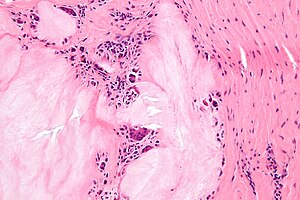Gout
Jump to navigation
Jump to search
The printable version is no longer supported and may have rendering errors. Please update your browser bookmarks and please use the default browser print function instead.
| Gout | |
|---|---|
| Diagnosis in short | |
 Gouty tophus. H&E stain. | |
|
| |
| LM | urate crystals - considered gold standard (see crystals in body fluids) not seen on formalin fixed sections, tophi (granulomatous inflammation - surrounds fluffy (cotton candy-like) material), fibrotic synovium |
| Site | joints - classically large toe |
|
| |
| Associated Dx | +/-chronic renal failure, +/-diabetes mellitus |
| Clinical history | usually male |
| Symptoms | joint pain |
| Prevalence | common |
| Blood work | urea elevated |
| Prognosis | benign |
| Clin. DDx | other causes of joint pain - see arthritis |
| Treatment | medications (NSAIDs for pain, allopurinol, colchicine) |
Gout is a common benign affliction that can be disabling. It occasionally is seen by pathologists. It can be grouped in conditions with crystals in body fluids.
General
- Classically afflicts the big toe - known as podagra.
Epidemiology:[1]
- Male (Females relative risk ~ 0.1).
- Renal failure.
- Diabetes mellitus.
Etiology:[2]
- Overproduction of uric acid ~ 10% of cases.
- Reduced excretion of uric acid ~ 90% of cases.
Treatments:[5]
- NSAIDs.
- Allopurinol.
- Colchicine - prophylatic.
Gross/radiology
- Radiologically may mimic anconeus epitrochlearis muscle.[6]
DDx:
- Epidermal inclusion cyst. (???)
Microscopic
Features:[7]
- Tophi (advanced)
- Reactive granulomatous inflammation.
- Surrounds fluffy (cotton candy-like) material.
- Fibrotic synovium.
- Reactive granulomatous inflammation.
- Aggregates of urate crystals - considered gold standard.[8] ‡
Note:
- ‡ The crystals with the classically described polarization of light (see crystals in body fluids) is not present in formalin fixed tissue.[9]
Images
Urate crystals under polarized light. (WC/Gabriel Caponetti)
www
- Gouty tophus - A. xray, B. Diff-Quick, C. Pap smear, D. polarized light, E. H&E (archivesofpathology.org).
- Gout - several images (upmc.edu).
Sign out
Submitted as "Left Olecranon Bursa", Excision:
- Consistent with gouty tophus; amorphous material with granulomatous reaction.
See also
References
- ↑ Wang, Y.; Yan, S.; Li, C.; Zhao, S.; Lv, J.; Wang, F.; Meng, D.; Han, L. et al. (Mar 2013). "Risk factors for gout developed from hyperuricemia in China: a five-year prospective cohort study.". Rheumatol Int 33 (3): 705-10. doi:10.1007/s00296-012-2439-8. PMID 22544037.
- ↑ Mitchell, Richard; Kumar, Vinay; Fausto, Nelson; Abbas, Abul K.; Aster, Jon (2011). Pocket Companion to Robbins & Cotran Pathologic Basis of Disease (8th ed.). Elsevier Saunders. pp. 634. ISBN 978-1416054542.
- ↑ Online 'Mendelian Inheritance in Man' (OMIM) 607096
- ↑ Tin, A.; Woodward, OM.; Kao, WH.; Liu, CT.; Lu, X.; Nalls, MA.; Shriner, D.; Semmo, M. et al. (Oct 2011). "Genome-wide association study for serum urate concentrations and gout among African Americans identifies genomic risk loci and a novel URAT1 loss-of-function allele.". Hum Mol Genet 20 (20): 4056-68. doi:10.1093/hmg/ddr307. PMID 21768215.
- ↑ Eggebeen, AT. (Sep 2007). "Gout: an update.". Am Fam Physician 76 (6): 801-8. PMID 17910294.
- ↑ URL: http://radiology.casereports.net/index.php/rcr/article/viewArticle/57/213. Accessed on: 7 August 2011.
- ↑ URL: http://pathologyoutlines.com/joints.html#gout. Accessed on: 5 August 2011.
- ↑ Ting, K.; Graf, SW.; Whittle, SL. (Jul 2015). "Update on the diagnosis and management of gout.". Med J Aust 203 (2): 86-8. PMID 26175247.
- ↑ Shidham, V.; Chivukula, M.; Basir, Z.; Shidham, G. (Aug 2001). "Evaluation of crystals in formalin-fixed, paraffin-embedded tissue sections for the differential diagnosis of pseudogout, gout, and tumoral calcinosis.". Mod Pathol 14 (8): 806-10. doi:10.1038/modpathol.3880394. PMID 11504841.


